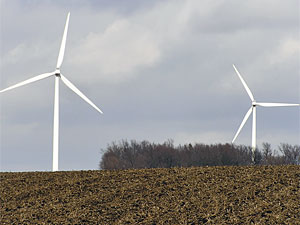BP will close its solar-panel manufacturing plant in Frederick, the final step in moving its solar business out of the United States to facilities in China, India and other countries.
Just 3 1/2 years ago, in an announcement widely hailed by Maryland officials and promoters of "green jobs," BP unveiled a $70 million plan to double output at the facility and erected a building to house the production lines.
But on Friday the company said it would lay off 320 workers and keep only a hundred people involved in research, sales and project development. BP said laid-off employees would receive full pay and benefits for three months, followed by severance packages and job-placement assistance. The company, unable to sell or lease the building, will tear it down.
"We remain absolutely committed to solar," BP chief executive Tony Hayward said in an interview Friday. But he said BP was "moving to where we can manufacture cheaply."
The company said in a news release that by closing down high-cost manufacturing locations, BP slashed unit costs by more than 45 percent.
A few years ago, under the leadership of then-chief executive John Browne, BP said that its initials should stand for "beyond petroleum" and that the solar business was a key part of that new image even though it remained a tiny part of the oil and gas giant. Hayward, who came up through the oil-and-gas-exploration side of the company, said BP remains committed to renewable energy where it makes economic sense.
"The bit about 'beyond petroleum' being dead and buried is nonsense," he said. But, he added, "it's a business as opposed to an advertising slogan." He said that "we believe there are real business opportunities" and that BP would "be pursuing them in a far more business-like way than we did when everyone thought we were 'beyond petroleum.' "
if ( show_doubleclick_ad && ( adTemplate & INLINE_ARTICLE_AD ) == INLINE_ARTICLE_AD && inlineAdGraf )
{
placeAd('ARTICLE',commercialNode,20,'inline=y;',true) ;
}
function ebStdBanner0_DoFSCommand(command,args){try{command = command.replace(/FSCommand:/ig,"");if((command.toLowerCase()=="ebinteraction") (command.toLowerCase()=="ebclickthrough"))gEbStdBanners[0].handleInteraction();}catch(e){}}function ebIsFlashExtInterfaceExist(){return true;}
try{ebStdBanner0_DoFSCommand(command,args);}catch(e){}
') ;
}
// -->
BP, which has been in the solar business for 37 years, acquired a half-interest in the Frederick plant when it bought Amoco Corp. in 1999; it bought the rest from Enron. At one point, BP was the world's second-largest solar company. Today, it ranks in the top 15, though it hopes to grow.
Intense competition and high silicon prices made the solar sector "a very challenging business," Hayward said. Reyad Fezzani, chief executive of BP Solar, said that the U.S. market, which grew 87 percent in 2008, was almost flat in 2009, with prices for solar modules tumbling about 50 percent.
BP also has made missteps. It was producing 125 millimeter multi-crystalline solar cells in Frederick while the rest of the industry had moved to 156 millimeter cells, which have become standard. Changing the production lines would be too expensive, Fezzani said.
Elsewhere in the United States, BP built and then closed two plants using technologies that the company said had showed early promise. "They were very experimental. And those factories weren't successful in making commercial products," Fezzani said.
Anticipating renewed growth in the U.S. market, other companies -- including Yingli Solar of China, Schott Solar of Germany and Kyocera Solar of Japan -- are planning to open facilities in the United States.
But BP plans to rely on a 25-year-old joint venture with Tata in Bangalore, India, and on an eight-year-old joint venture in Xian, China, with a Chinese firm called SunOasis. BP buys silicon from a variety of suppliers and uses contract factories in which it holds no interest. BP Solar said in January that Jabil Circuit would build a module assembly plant in Chihuahua, Mexico, to serve the U.S. market.
BP has applied to the Energy Department to help finance a proposed 32 megawatt solar-power generation plant on Long Island, N.Y., on land belonging to the Energy Department's Brookhaven National Laboratory.
Sensitive to questions about whether U.S. tax dollars would be helping foreign manufacturers, Fezzani said that "70 percent of our jobs are outside the factory," in design, construction, installation and maintenance. He said BP recently certified 150 installers, "all small businesses."
In 2006, a worker interviewed while monitoring the furnaces used to melt silicon at the Federick plant said, "I could retire here." That won't happen now.
"A few years ago conditions were different," Fezzani said. "The margins were healthier. There was a shortage in the market. But since then, the market has changed. We just couldn't make the economics of this factory work."
http://www.washingtonpost.com/wp-dyn/content/article/2010/03/26/AR2010032604611.html?wprss=rss_business
Top of blog:http://www.usaalternativeenergynow.blogspot.com/
Subscribe to:
Post Comments (Atom)



No comments:
Post a Comment